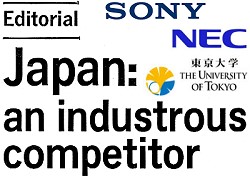Japan: An Industrious Competitor
|
|
"Japanese electronics firms' real strength is their engineers, characterized by creativity, ingenuity and an awesome willingness to work long and hard." That statement by editor Lewis Young is the key point in this article that appeared in a 1965 issue of Electronics magazine. That Japanese technology companies were deemed to be only about five years behind the U.S. was a real wake-up call to America and the European countries. Both Europe and Japan had been very diligent about rebuilding and modernizing techniques and infrastructure since the destruction caused by World War II. A few stories about Japan's post-war efforts report on how the government left most of the responsibility (aka financing) up to universities and private companies. Industry in some of the more Socialist countries of Europe had the assistance of taxpayer subsidization and the willingness of governments to take on debt to funnel investment money to corporations. All these articles appeared in this issue: Westernizing Japan | Japanese Technology - The New Push for Technical Leadership | Japanese Technology - When You're Second, You Try Harder | Japan Stresses Research | Japan: An Industrious Competitor Japan: An Industrious Competitor
When Japanese companies exhibited for the first time at the International Components Show in Paris last April, European electronics companies were clearly worried. The Japanese have a way of moving into a market and dominating it. Throughout the world, their electronics concerns are feared and respected. On the surface there seems to be no reason for these companies to cause such agitation in foreign competitors. Japanese technology is "five years behind that in the United States," according to Prof. Hiroshi Inose of Tokyo University, who has worked at the Bell Telephone Laboratories in the U. S. Japanese research facilities are usually small and crowded with equipment. Plants are shabby for the most part, many still bearing the scars of bombings during World War II. Nor is cheap labor the principal asset of Japan's electronics industry. Wages are rising rapidly, 10% to 13% a year. Japanese electronics firms' real strength is their engineers, characterized by creativity, ingenuity and an awesome willingness to work long and hard. American executives who worry about competition from Japan might be surprised at the pains to which the Japanese go to avoid face-to-face competition with American products. It was this reluctance to compete directly that prompted the Sony Corp. to develop a color-television receiver that uses a Chromatron tube instead of the shadow-mask tube used by manufacturers in the United States. Research money is hard to come by; almost every Japanese executive bemoans the paucity of government money to finance research and development. Most fundamental research is done at the universities; companies concentrate on development of products. Until recently, the Japanese electronics industry has concentrated on consumer products. Now the industry is changing, designing more sophisticated equipment for industrial and commercial uses. Before 1966, Japanese firms expect to introduce such new products as a low-priced, large-capacity computer for direct digital control of industrial processes, using integrated circuits and designed around the requirements of a chemical plant; an electronic calculator, also built with integrated circuits; and a microwave oscillator operating on the Gunn-effect principle. The Japanese engineer must be just about the hardest-working in the world. Although the official work week is 43 to 45 hours, many engineers remain on the job 65 and 70 hours a week. At the Nippon Electric Co. plant at Tamagawa, where an integrated-circuit production line is being installed, the project engineer often works 30 hours at a stretch. Sony's chief engineer for advanced television engineering routinely works 70 hours a week. Money is not the incentive, because Japanese engineers' pay is shockingly low. A college graduate in his first job receives about 24,000 yen a month - about $67. After five years, his earning increases to $84 a month plus an annual bonus of six or seven months' pay. After 15 years, a typical electronics engineer receives $145 to $200 a month. Besides direct pay, the Japanese engineer receives far more fringe benefits than does his American counterpart: such extras as free housing, work clothes, daily tea, hospitalization, free schooling for his children, stays at mountain resorts at ridiculously low rates, and a retirement program. The Japanese engineer's greatest compensation is likely to be recognition - publication of his work or praise of his technical competence by his associates - particularly recognition from colleagues in the U. S. To many a Japanese engineer, a highlight of a career is an invitation to present a technical paper at an American technical society. One Japanese executive may have been speaking for the entire electronics industry in his country when he said: "Our engineering is our greatest strength. I think one of our engineers does the work of two American engineers." That human resource goes a long way toward overcoming Japan's deficiency in natural wealth.
Posted November 9, 2023 |
|

 This is the first in a series of editorials
on the Far East by Lewis H. Young, editor, who is on a trip through Japan, Hong
Kong and Taiwan.
This is the first in a series of editorials
on the Far East by Lewis H. Young, editor, who is on a trip through Japan, Hong
Kong and Taiwan.